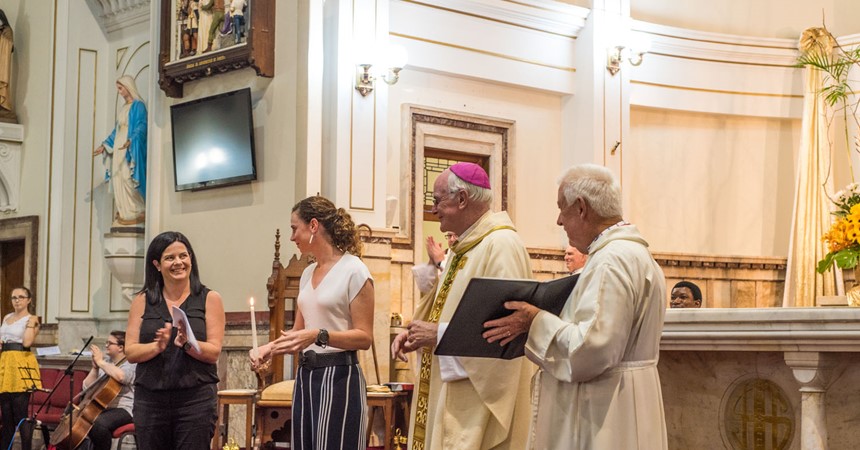The central question is, “How does a faith community celebrate or party for 50 days?’ The manner of that celebration is inscribed in the liturgy, beginning with the Easter Triduum – with its highpoint, in what the church officially calls ‘the mother of all vigils’ – and unfolding Sunday by Sunday through the Easter Season right up to and including Pentecost. And I kid you not, that is how the documents refer to the Easter Vigil!
When we gather every year to celebrate Easter liturgically – whether in the whole three-part Triduum, part of it, or Easter Sunday Mass – we are participating with Christ in his death and resurrection. We die and we rise with him. Our celebration inscribes this dying-rising pattern of God’s love deep within our minds and hearts.
Because God’s ways are so far beyond our ways, this ‘inscribing’ can be difficult. And so the whole 50 days of the Easter Season is given over to a liturgical intensive on Christ’s death and resurrection, driving the ‘inscription’ into our bones and muscle memory, so that the dying-rising pattern of God’s love becomes the instinctual pattern of our daily lives.
This is where the term ‘mystagogy’ comes in. The title of this piece echoes a common response when people hear or read the term for the first time. ‘Mysta what?’ In mystagogy we open ourselves to be formed by and learn from experience, most importantly from the experience of Sunday Mass.
In taking time to reflect on Christ present in all the symbols and ritual actions, in word and sacrament, we deepen our awareness of being immersed into the life of Christ, and our appreciation of what it means for everyday life and our ongoing conversion. The meanings we discover through the process of mystagogy work their way into our bones and muscle memory because they are meanings revealed to us in our experience of God’s paschal love in the liturgy.
The period of Easter Mystagogy (also known as post baptismal catechesis) is focused on the newly baptised who for the first twelve months are known as neophytes and hold a special place within the community. However, Easter Mystagogy is as much about the whole parish community. We journey together through this liturgical intensive, learning from and being inspired by each other.
The following quote from neophyte Mary is an example of how deeply mystagogy unites experience and truth.
‘When I tried to rub off the globs of oil running down my cheeks and, on my body, I realised what I had just done. I can’t rub it off, but I can rub it in. I can’t even wash it off – that really is what this is all about isn’t it? I belong to God, signed, sealed and delivered!’
As someone whose baptism was a long time ago, I am always deeply inspired, firstly by the experience of participating in the initiation of the neophytes, and then by their reflections and insights shared with us through the easter Season.
Hopefully parishes are making the most of these early mystagogical days this Easter Season. As we continue our synodal journey, reflecting on the meaning of our life as a diocesan community, seeking to build the Kingdom of God together, the Easter Season presents us with an invaluable built-in opportunity to attune ourselves to the dying-rising presence of God and discern its meaning for our lives. Let’s not miss it.
After Pentecost, when the party is over, we move back into Ordinary Time where our life in Christ continues to be nourished in the normal rhythm of gathering as a community for Sunday Mass. In the church’s mind and vision, the process of mystagogy continues in a slightly different way as the parish community accompanies its seekers, catechumens and candidates for full communion.
And the last word goes to Betty, another neophyte:
I never knew how hungry I was, It was all so wonderful: the music, the stories, the word, the sharing, the people! For weeks I was becoming hungrier and hungrier. I thought the day would never come. I never really understood what true hunger meant before now. I know it now, because I know what it means to be filled.
How does a faith community celebrate for 50 days? By accompanying each other in mystagogical reflection, particularly on our liturgical experience of Christ’s dying-rising presence. We are all mystagogues. How comfortable are you with that description? Give it a go. Reflect on your last liturgical experience using the following process: remember the liturgy and reflect on the questions:
- What happened? (Recollection)
- What did you notice? What was most engaging? (Reflection)
- What does it mean? What are you learning? (Catechesis)
- Why does it matter to you/us? (Connection)
- How will you live differently as a result of what God is revealing to you in this experience? (Conversion)
You could also gather a group and try it.
Acknowledgements
Quotes from Birmingham, Mary. Year – Round Catechumenate. Chicago Il, Liturgy Training Publications, 2003, 2002. p. 121
Picture: © Diocese of Maitland-Newcastle. All rights reserved.

